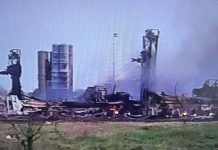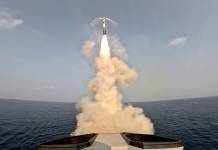As Russia’s Ukraine offensive completes a month, the war has not only remained inconclusive but also deadlier with each passing day. In the face of stiff resistance from Ukrainian troops and civilians, the Russian Army has resorted to the use of artillery shelling on key cities, which according to reports, include civilian areas.
Setback For Moscow? Ukraine Seizes Russia’s ‘Most-Powerful’ EW System That Could Give Kyiv Critical Edge In The War
The Ukrainian forces have also made notable use of artillery throughout the ongoing war. As EurAsian Times reported earlier, the Ukrainian artillery ambushed a column of Russian tanks and armored vehicles headed towards Kyiv and forced them to retreat.
As both sides make extensive use of artillery to suppress the enemy position, the most lethal gun in either side’s arsenal is the Soviet-era 203 mm self-propelled 2S7 howitzer, which is purportedly also the most powerful gun in the world.
On March 21, Ukrainian forces released a video of their 2S7 gun in action at an unspecified location.
Analysts have geolocated this video to an area west of Donetsk frontline suggesting that the footage might have been recorded in the early days of the war in late February before the Russian forces advanced towards that position.

The 2S7 howitzer combines a 203 mm 2A44 gun with a tracked chassis featuring all-welded steel armor. The design came from the Kirov Factory in the 1960s and it entered service with the Soviet army in 1976.
It was initially known as the ‘Pion’ (Russia for peony, a kind of flower), but following the upgrades to the chassis, engine, ammunition loading system, and fire control in 1983 the gun was renamed as 2S7M ‘Malka’.
The #Russian 2S7 Malka ( mordenised Pion) pic.twitter.com/q9tUyWowm4
— Ninjamonkey ?? (@Aryan_warlord) March 22, 2022
Deadly Capabilities
The first combat deployment of the 2S7 was during the Soviet-Afghan War and later Russian forces used it in the first and second Chechen wars. The Georgian army also fielded a battery of six 2S7 guns during its conflict with Russia in 2008, but those were all captured by Russian troops who destroyed five of them retaining one.
J-11B Fighters – China ‘Ditches’ Its Aging Pulse-Doppler For New, Powerful Radars; Uses Them For Military Drills In SCS
Some of the main munitions fired include high-explosive fragmentation and rocket-assisted projectiles. The former weighs 110 kg and contains 17.8 kg of projectiles while the latter projectile weighs 103 kg and contains 13.8 kg of explosives.
Without any type of rocket assistance, the 2A44 gun can hit targets at a range of 37.5 km (roughly 23 miles) while rocket-assisted projectiles can reach a range of 47.5 km (roughly 29 miles).
Eight projectiles can be carried in the 2S7M version of the vehicle with auxiliary vehicles having more ammunition inside, which is then delivered using hand carts. The ammunition handling system can provide a rate of fire of 2.5 rounds per minute.
The gun can also fire anti-concrete, nuclear and chemical shells and is provided with a nuclear, biological, and chemical (NBC) protection system.
Return To Active Service
The Russians eventually put a lot of their roughly 300 2S7s in storage. The Ukrainians who inherited 100 or so 2S7s from the Soviet Union also did the same.
Ukraine was compelled to re-activate its 2S7s in 2014 after its forces were hammered by artillery fire from Russian separatists in the Donbass region. Reports suggest that the army took out at least 13 2S7s from the storage and sent them to the Shepetivka Repair Plant in Rivne for overhaul.
Meanwhile, the Russian forces also appear to have fielded their own 2S7s in Russia’s Belgorod region possibly operated by the 45th Artillery Brigade near the city of Kharkiv in eastern Ukraine as well as in Crimea
The Military Balance said in 2018 that the Russian artillery was armed with 60 Malka guns, which according to reports, have undergone major upgrades.
The new guns are equipped with digital electronics to make them a part of the army’s sophisticated fire-control system. This system combines drones and ground-based radars and electronic eavesdroppers to spot targets and relay coordinates to the guns.
These upgrades are said to help Russian gunners to fire faster at new targets than their Ukrainian counterparts.
For example, in February 2015 during a brutal clash over the town of Debaltseve in the Donetsk region, Russian 2S7s pounded the Ukrainian positions. The Ukrainian soldiers claimed, for every salvo they fired, they received 10 to 15 salvos in return.
“Accounts of Ukrainian soldiers being targeted by artillery, just seconds after being spotted by a UAV or after making use of their phones, were numerous over the course of the battle,“ Small Wars Journal noted.
Last week, a video released on social media purportedly showed an ammunition depo near Kharkiv being destroyed by a Russian strike. It is believed the 2S7 Malka was used in this assault.
Furthermore, in December 2021, the Russian Army received a batch of 2S7s that have perhaps undergone yet another set of upgrades by Uralvagonzavod, a subsidiary of the state-owned Rostec.
- Written by Tanmay Kadam/EurAsian Times Desk
- Contact the author at etdesk@eurasiantimes.com
- Follow EurAsian Times on Google News





